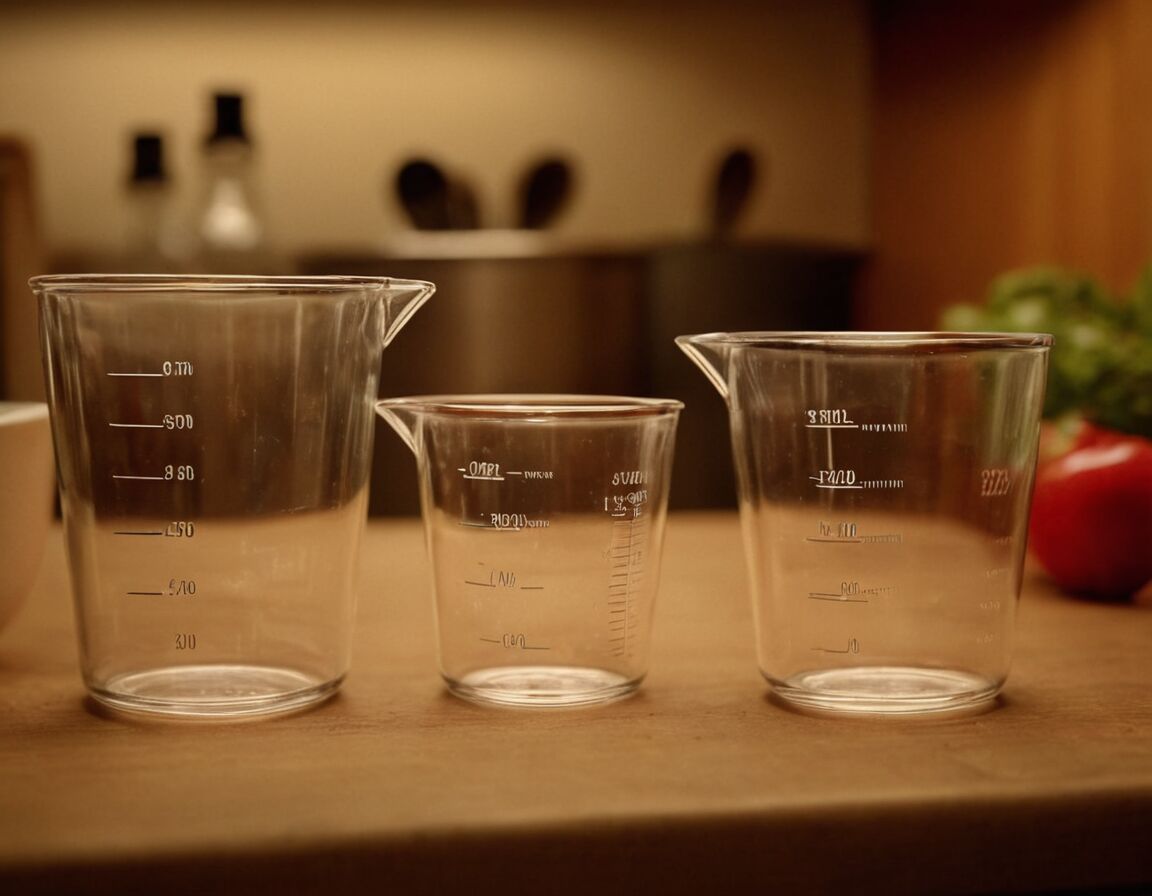Understanding measurement conversions is a key part of successful cooking and baking. When working with liquids, knowing how many cups are in a quart can simplify recipes and improve accuracy. The most common standard in the United States states that a quart equals four cups, with each cup holding 8 fluid ounces. Paying attention to measurement units and using appropriate tools ensures precise results, whether preparing a small batch or cooking for a larger group.
Viktiga slutsatser
- One quart equals four cups in the US measurement system.
- Each cup holds exactly 8 fluid ounces—important for precise liquid measurement.
- Use proper measuring tools and level dry ingredients for accuracy in recipes.
- Verify the measurement system used—US, metric, or international—to avoid errors.
- Liquid and dry measurements differ; use appropriate cups and techniques for each.
A quart equals four cups
In the standard US measurement system, a quart is equivalent to four cups. This means that when a recipe calls for one quart of liquid, you can confidently measure it using four individual cups. Each cup holds 8 fluid ounces, so together they make up a total of 32 fluid ounces per quart. Understanding this simple conversion can make cooking and baking more straightforward, especially when measuring ingredients precisely.
Using the right tools, such as a set of standard measuring cups, helps ensure accuracy in your measurements. It’s important to note that these conversions apply specifically to liquid measurements in the US customary system. When working with dry ingredients, the actual volume may vary slightly due to differences in consistency or how ingredients are packed. Throughout the process, paying attention to the measurement units and maintaining consistency contributes to better results in culinary preparations.
Overall, knowing that a quart equals four cups simplifies many aspects of preparing recipes, whether you’re adjusting quantities or ensuring proper proportions. Having this knowledge handy allows for quick calculations and avoids confusion, especially in situations where precise measurements play a crucial role in achieving the desired outcome.
Användbara länkar: The Rise of Jorts: How Denim Shorts Became a Fashion Staple in Summer Wardrobes
Each cup is 8 fluid ounces

Each cup used in standard US measurements holds exactly 8 fluid ounces. This measurement is a common reference point for many recipes and kitchen activities, making it vital to understand accurately. When measuring liquids, using the correct cup size ensures consistency, especially when following a recipe or preparing beverages.
The distinction between fluid ounces and dry ounces is important to recognize. Fluid ounces measure volume, which applies directly to liquids like water, milk, or broth. Conversely, dry ounces measure weight, which can vary depending on the ingredient’s density. Therefore, relying on a standard liquid measuring cup helps maintain accuracy in recipes that specify fluid ounces.
In practical use, filling a cup just up to its rim without overflowing guarantees precise measurements. Pouring liquids slowly and checking at eye level prevents errors caused by not noticing the meniscus—the slight curve formed at the surface of a liquid in a container. For best results, it’s advisable to use clear, graduated measuring cups marked with fluid ounce increments.
Understanding that one cup contains 8 fluid ounces allows for easy conversions, such as quickly calculating how many cups are needed for a specific amount of fluid expressed in ounces. This knowledge enables cooks and bakers to adapt recipes efficiently, ensuring the right proportions every time and reducing waste or inaccuracies during preparation.
Standard US measurements apply
In the context of cooking and baking, it is important to recognize that standard US measurement units are widely used and accepted for most recipes. These measurements provide consistency, allowing both amateur cooks and professionals to prepare dishes with predictable results. When a recipe indicates cups, quarts, or fluid ounces, it generally refers to the US customary system. Being familiar with this system helps ensure accurate portioning and ingredient management during food preparation.
Accuracy becomes especially critical in baking, where the slightest deviation can affect texture and outcome. Using measurement tools calibrated for US standards, such as standard measuring cups and spoons, increases the likelihood of success. It’s worth noting that these specifications differ from international measurement systems, like the metric system, which uses liters and grams. Therefore, when following recipes from different origins, adjustments may be necessary if you want to maintain consistency.
Additionally, understanding that typical US measurements assume specific volume standards ensures clarity in instructions and reduces errors. For example, knowing that one cup equals 8 fluid ounces allows quick calculation of required quantities. This familiarity fosters confidence in scaling recipes up or down as needed, helping to achieve the desired taste and texture consistently.
Cooking is all about confidence and measurement — knowing that a quart equals four cups simplifies the process. – Julia Child
Check the measurement system used
Before beginning to measure ingredients, it is important to verify the measurement system being used in your recipe or by your measuring tools. Different countries and regions may use varying standards for volume and weight, so understanding which system applies can prevent confusion and inaccuracies. For instance, the US customary system uses cups, fluid ounces, quarts, and other units that differ from metric measurements, such as liters and milliliters.
Checking the measurement system ensures you select the correct tools and interpret the recipe accurately. If a recipe originates from another country, verify whether the measurements are based on metric units or US standard units. This step helps avoid mistakes like using a cup meant for dry ingredients when measuring liquids or misinterpreting fluid ounces as weight ounces. Additionally, some recipes might specify whether the measurements are intended as liquid or dry, which can influence how you fill measuring cups and spoons.
Being attentive to the measurement system used also allows for better adjustments if needed. When scaling recipes up or down, knowing the foundation of the measurement units helps maintain proper ratios and proportions. Always double-check markings on measuring tools to confirm they correspond with the intended system, especially when precision is critical. Awareness of this detail improves accuracy and ultimately contributes to successful culinary results.
Se även nedan: The Best Spots to Watch the Sunset Today: A Guide for Nature Lovers
| Measurement | Detaljer |
|---|---|
| 1 Quart | Equals 4 cups |
| 1 Cup | Holds 8 fluid ounces |
| US standard measurement system | Applies to liquids and dry ingredients, but conversions can vary internationally |
Liquid vs dry measurement differences

Förståelse för difference between liquid and dry measurements is crucial for accurate cooking and baking. While both types of measurements might use similar units, they are not interchangeable due to the distinct way they are measured. Liquids are typically measured using fluid ounces or cups, which represent volume. In contrast, dry ingredients are usually indicated by weight, often in ounces or grams. This distinction means that a cup of flour will weigh differently than a cup of water, making precise measurement important for consistent results.
When measuring liquids, it is vital to use clear, graduated containers designed for this purpose. The meniscus, or the curved surface at the top of a liquid, should be viewed at eye level to ensure accuracy. On the other hand, dry ingredients are best measured with dry measuring cups, which allow you to fill them level with a straight edge. Properly leveling off dry ingredients ensures you do not accidentally add too much or too little, affecting the texture and outcome of your recipe.
Failure to recognize these differences can lead to unexpected changes in taste and texture. For example, adding too much dry flour can result in dense baked goods, while excess liquid can make a dish overly runny. Being aware of whether your recipe calls for liquid or dry measurements and using the correct tools helps achieve consistency and professional results in the kitchen. Always double-check if the recipe specifies the type of measurement required to avoid discrepancies.
Recommendation: The Rise of Travis Decker: Innovating the Future of Sustainable Architecture
Using measuring cups for accuracy

Using measuring cups accurately is crucial for achieving consistent results in cooking and baking. When measuring liquids, it is important to fill the cup slowly, ensuring that the liquid reaches the desired level without overflowing. To improve precision, always check the measurement at eye level; this helps avoid parallax errors and guarantees you are reading the correct mark on the cup. Additionally, when pouring, it is helpful to use a steady hand and pour in small amounts, especially if the recipe calls for exact measurements.
Leveling off dry ingredients correctly also plays a significant role in maintaining accuracy. After filling the measuring cup, use a straight edge or knife to wipe away excess, making sure the ingredient is perfectly leveled with the top of the cup. This step prevents over-measuring and ensures your mixture has the correct proportions.\n\nMoreover, employing transparent, graduated measuring cups made specifically for liquids can assist in better visualization of volume. Clear cups allow you to see the meniscus, the curved surface of the liquid, which should be aligned with the marking for precise measurement. These simple practices help eliminate common errors and lead to more reliable and successful culinary outcomes.
Conversions can vary internationally
International measurement standards can differ significantly from those used in the United States, which means that conversions are not always straightforward. For example, while a quart is equal to four cups in the US system, other countries like Canada or the UK may use different definitions for volume units. In some regions, the size of a cup varies, with metric cups often measuring 250 milliliters, whereas US cups measure approximately 237 milliliters. This small difference can impact recipes when they are transferred across borders.
Furthermore, liquid measurements such as quarts and gallons might be defined differently depending on regional practices. It’s important to verify which standard applies before starting to cook or bake internationally. When following recipes sourced from other countries, you might need to make adjustments or use precise conversion tools to avoid inaccuracies. Using an inaccurate conversion can lead to ingredients being over- or under-measured, ultimately affecting the intended outcome of a dish.
In addition to unit variations, terminology may also pose confusion. Some regions refer to a “cup” as a smaller or larger volume than the US standard. Consequently, it’s recommended to check the official measurement descriptions and use reliable conversion references. Employing these methods helps ensure consistency, especially when working with international recipes or shopping for ingredients abroad. Always consider these differences to maintain accuracy and achieve the best results regardless of location.
Remember to level off dry ingredients
When measuring dry ingredients, it is crucial to level off the surface after filling your measuring cup. This step ensures your measurements are accurate and consistent, which is especially important when baking or following precise recipes. To do this correctly, fill the measuring cup slightly above the desired amount, then use a straight-edged tool such as a butter knife or spatula to carefully sweep across the top of the ingredient, removing any excess.
This process of leveling off helps avoid over-measuring, preventing more than the intended amount from being added to your mixture. Even a small excess can significantly alter the outcome of baked goods, leading to dense textures or other inconsistencies. It’s useful to remember that this technique applies both to powders like flour or cocoa, as well as granular ingredients such as sugar or salt.
For best results, make sure to use the same measuring cup for the entire process and check the measurement at eye level to prevent parallax errors. Properly leveled ingredients contribute to achieving uniformity in recipes and can make the difference between a successful dish and one that doesn’t meet expectations. With these practices, you ensure each ingredient contributes its correct proportion, resulting in dishes with better taste and texture.
FRÅGOR OCH SVAR: Svar på dina frågor
How many fluid ounces are in a quart?
Can I use dry measuring cups for liquids?
What is the equivalent of a quart in liters?
Are US and UK measurements the same?
Is the cup size the same for dry and liquid measurements?
Referenser:









